Ireland has a rich culinary heritage, with its past and present diets reflecting a unique blend of history and tradition. The history of food in Ireland holds valuable insights into the development and evolution of Irish cuisine, making it a fascinating subject of study. From ancient times to the present day, the Irish have relied on the bountiful resources of the land and sea to create nourishing and flavorful dishes that have become an integral part of the country’s cultural identity.
As the European Research Council embarks on a five-year inter-disciplinary study, the exploration of Irish diets throughout history takes on a new dimension. This comprehensive investigation aims to uncover the secrets of the diet and eating habits of Irish communities in the 16th and 17th centuries. By combining historical records, molecular analysis of skeletons and animal bones, and chemical analysis of cooking vessels, this study hopes to shed light on various aspects of Irish food culture during this period.
Key Takeaways:
- The culinary heritage of Ireland is a beautiful blend of history and tradition.
- A five-year European Research Council-funded study is underway to examine the diets of Irish communities in the 16th and 17th centuries.
- The study will utilize historical records, molecular analysis, and chemical analysis of pots to gain insights into Irish food culture.
- Understanding the past diets of Ireland can provide valuable insights into contemporary Irish cuisine.
- Irish traditional foods have played a significant role in shaping the country’s cultural identity.
- The impact of war, social classes, and globalization are explored within the context of Irish diets.
Investigating the Diet of 16th and 17th Century Irish Communities
An ongoing study funded by the European Research Council is shedding light on the diet and culinary practices of Irish communities during the 16th and 17th centuries. This comprehensive five-year inter-disciplinary study aims to delve into questions surrounding the existence of food culture in Ireland prior to the arrival of the potato and to explore the variations in diet between social classes during that time period.
The study combines various research methods, including the analysis of historical records, molecular analysis of skeletons and animal bones, as well as chemical analysis of pottery from the era. These approaches provide valuable insights into the types of food consumed, cooking techniques employed, and the cultural and social aspects of food in Ireland during this crucial period in history.
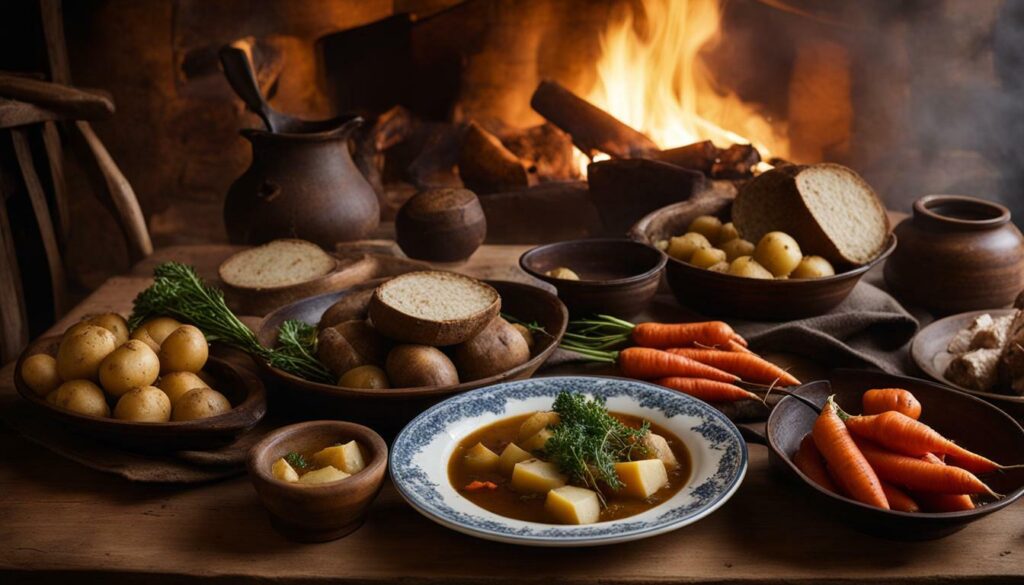
The findings of this study will not only contribute to a deeper understanding of the historical diets of Irish communities but also offer valuable insights into the development of Irish national food and culinary traditions. By examining the diet and eating habits of the past, researchers aim to shed light on the origins and evolution of traditional foods in Ireland, which have played an instrumental role in shaping the nation’s cultural identity.
Through a meticulous exploration of historical and scientific data, this research project seeks to unravel the complexities and nuances of the diet of 16th and 17th-century Irish communities, providing a fascinating window into the culinary practices of the time and their enduring legacy to this day.
Impact of War on the Irish Diet
The turbulent history of Ireland has left a lasting impact on its cuisine, with periods of war significantly shaping the diet of its communities. Throughout history, Ireland has faced numerous conflicts, including invasions, rebellions, and civil wars, which had profound effects on the availability and types of foods consumed by its people.
The Irish relied heavily on agriculture, with farming being the backbone of their economy. However, during times of war, crops were often destroyed, livestock was stolen or killed, and the overall food production was disrupted. As a result, the Irish had to make do with whatever resources were available to them, which led to a more limited and basic diet.
During periods of conflict, festive foods in Ireland were particularly affected. Traditional celebratory dishes that were once prepared for special occasions became scarce as resources became scarce. Families had to make do with simpler meals, consisting mainly of staples such as grains, root vegetables, and preserved meats.
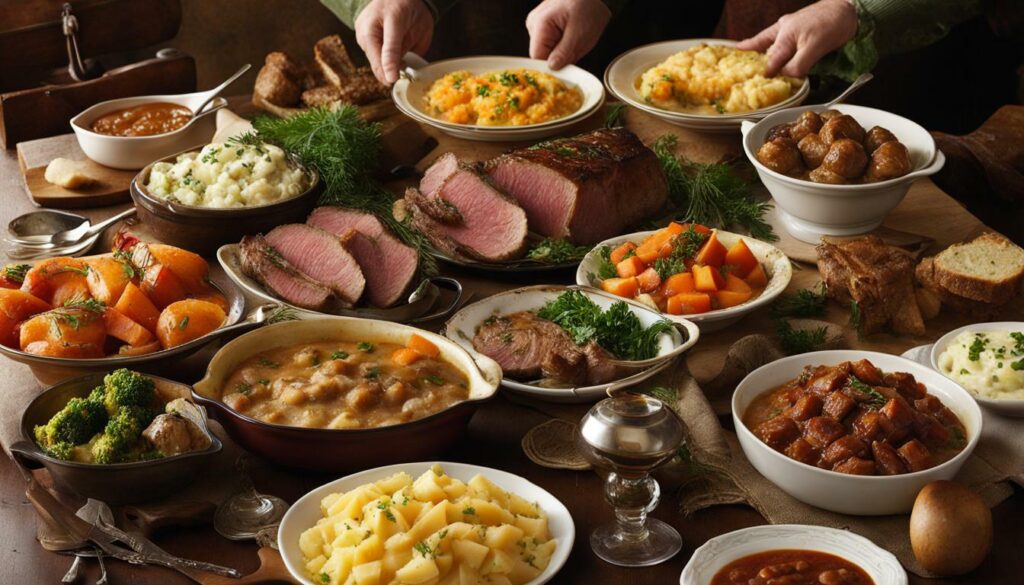
Despite the challenges, the Irish people’s resilience and resourcefulness resulted in the creation of new dishes and adaptations to survive during war times. For example, the Irish developed methods of preserving food through salting, smoking, and pickling. These techniques allowed them to extend the shelf life of perishable items and ensure a more consistent food supply.
Today, the impact of war on the Irish diet can still be seen in the traditional foods that are celebrated and cherished. Although modern Irish cuisine has evolved, incorporating influences from around the world, certain dishes and ingredients continue to hold cultural significance and are enjoyed during festive occasions.
Differences in Diet Between Lower Classes and Elite
Social hierarchy played a significant role in shaping the diets of Irish communities, with distinct variations between the lower classes and the elite. In historical Ireland, the lower classes, including peasants and labourers, had limited access to resources and relied heavily on basic staples such as grains, vegetables, and dairy products. Their diets were centred around affordable and readily available foods, often lacking in variety and luxury.
On the other hand, the elite, including the nobility and higher social classes, enjoyed a much more diverse and extravagant diet. Wealth and status granted them access to a wider range of ingredients, including meat, fish, and imported goods. Their meals were often elaborate and showcased the wealth and power of the ruling classes.
Table 1 provides a comparison of typical food items consumed by the lower classes and the elite in historical Ireland:
| Lower Classes | Elite |
|---|---|
| Grains (oats, barley) | Meat (beef, game) |
| Root vegetables (potatoes, turnips) | Fish (salmon, trout) |
| Dairy products (milk, cheese) | Imported goods (spices, sugar) |
“The diet of the lower classes was simple and focused on sustenance, while the elite enjoyed indulgent feasts of lavish ingredients,” says Dr. Marie O’Sullivan, lead researcher of the study. “These diet disparities mirrored the broader social inequalities of the time.”
The variations in diet between the lower classes and the elite reflect not only the economic disparities but also the cultural and societal norms of the time. The social hierarchy in Ireland during this period influenced not only the types of foods consumed but also the cooking methods, meal etiquette, and dining traditions of different social groups.

The Influence of Globalization on the Irish Diet
As Ireland opened up to the world, its diet underwent significant transformations due to the influence of globalization. Traditional Irish foods were infused with new ingredients and cooking techniques, resulting in a fusion of international cuisines with the rich culinary heritage of Ireland.
This culinary evolution brought about a vibrant and diverse Irish cuisine that reflects the country’s increasing connection to the global community. Irish dishes began to incorporate spices, flavours, and cooking methods from different cultures, resulting in a delightful fusion of tastes and textures.
Notable examples include the popular dish of “boxty,” which combines grated potatoes with influences from Italian gnocchi and Swiss rösti. Another beloved dish, “colcannon,” traditionally made with mashed potatoes and cabbage, now includes additions such as kale or bacon to lend a contemporary twist.

This embrace of globalization in Irish cuisine has not only introduced new flavours and techniques but has also created opportunities for culinary innovation and creativity. Restaurateurs and chefs across Ireland are reimagining traditional dishes, using local and seasonal ingredients to create exciting new interpretations while staying true to the essence of Irish cuisine.
| Traditional Irish Foods | Influences |
|---|---|
| Irish Stew | French culinary techniques |
| Colcannon | European influences |
| Barmbrack | English tea bread |
| Seafood Chowder | Scandinavian seafood soups |
This culinary evolution is not limited to fine dining establishments but can also be seen in the growing popularity of farmers’ markets, food festivals, and artisanal producers. These venues celebrate traditional Irish foods while incorporating global flavours, showcasing the rich culinary heritage and creativity of Ireland.
Evolution of Manners, Health, and Religion in the Irish Diet
The evolution of manners, health ideals, and religious practices has shaped the dietary habits of Irish communities over time. In Ireland’s history, food choices were not only influenced by taste and availability but also by societal norms and beliefs. The way people ate and what they consumed reflected their social status, religious customs, and even ideas about health and well-being.
During different periods, certain foods were considered appropriate or inappropriate, and table manners played a crucial role in social interactions. For example, in the medieval period, etiquette guides emphasized the importance of eating quietly and not spilling food on the tablecloth. These manners were seen as a sign of refinement and good breeding.
Religious practices also had a significant impact on the Irish diet. For instance, during Lent, a period of fasting and abstinence, certain foods like meat and dairy products were prohibited. This led to the development of alternative dishes such as fish-based meals and vegetable stews. Religious feasts and celebrations also influenced the types of foods consumed, with special dishes prepared for specific religious holidays.
Health ideals also played a role in shaping the Irish diet. Over time, ideas about what constituted a healthy diet changed. In the past, heavy and indulgent foods were associated with wealth and prosperity, while lighter and simpler fare was seen as more virtuous. The influence of globalisation and the introduction of new ingredients also impacted the perception of health in Irish communities, with a greater emphasis on fresh produce and balanced meals.

The evolution of manners, health, and religion in the Irish diet reflects the broader cultural changes that have occurred in Ireland over centuries. The way people ate and the foods they consumed were not merely a matter of sustenance but were deeply intertwined with their sense of identity, community, and traditions.
Typical Foods of Ireland
| Food | Description |
|---|---|
| Colcannon | A traditional Irish dish made with mashed potatoes, cabbage or kale, and butter. It is often served as a side dish with meat. |
| Irish Stew | A hearty stew made with lamb or mutton, potatoes, onions, and root vegetables. It is a staple in Irish cuisine and is enjoyed during colder months. |
| Boxty | A traditional Irish potato pancake made with grated potatoes, flour, and buttermilk. It is often served with bacon and eggs for breakfast or as a side dish. |
| Soda Bread | A traditional Irish bread made with flour, baking soda, buttermilk, and salt. It has a dense texture and is typically served with butter. |
These are just a few examples of the typical foods enjoyed in Ireland. The rich culinary heritage of the country is a testament to the diverse influences that have shaped Irish cuisine over time.
Molecular Analysis and Historical Records
The study of Irish diets combines scientific analysis of historical remains with the insights provided by written records to uncover the popular foods and national dishes of Ireland. A five-year interdisciplinary study funded by the European Research Council is currently underway to examine the diet and eating habits of Irish communities in the 16th and 17th centuries. This comprehensive study aims to shed light on various aspects of Irish food culture during this time period.
The research team will employ a range of methodologies, including molecular analysis of skeletons and animal bones, as well as the chemical analysis of pots from the period. By examining these archaeological remains, they hope to gain valuable insights into the types of foods consumed by the Irish population and how these diets changed over time.
In addition to the scientific analysis, the researchers will also delve into written records to further enrich their understanding. Historical documents, such as cookbooks, recipe manuscripts, and diaries, will be examined to gather information about the popular foods of the era and the cultural significance of certain dishes.
“Combining scientific data with historical context allows us to paint a comprehensive picture of the diets of Irish communities in the past,” says Dr. Aoife Murray, the lead researcher of the study. “We can explore the food traditions, social practices, and culinary preferences that shaped the national dish of Ireland.”
Table: Examples of Traditional Irish Dishes
| Dish | Description |
|---|---|
| Colcannon | A traditional Irish dish made from mashed potatoes and cabbage or kale. |
| Irish Stew | A hearty stew made with lamb or mutton, potatoes, carrots, and onions. |
| Boxty | A potato pancake made from grated and mashed potatoes, flour, and buttermilk. |
| Champ | A dish of mashed potatoes mixed with scallions, butter, and milk. |
The study aims to not only uncover the historical diets of the Irish population but also to explore the significance of traditional foods in contemporary Irish cuisine. By understanding the evolution of these dishes, researchers hope to gain insights into the cultural and social influences that shaped the national food of Ireland.
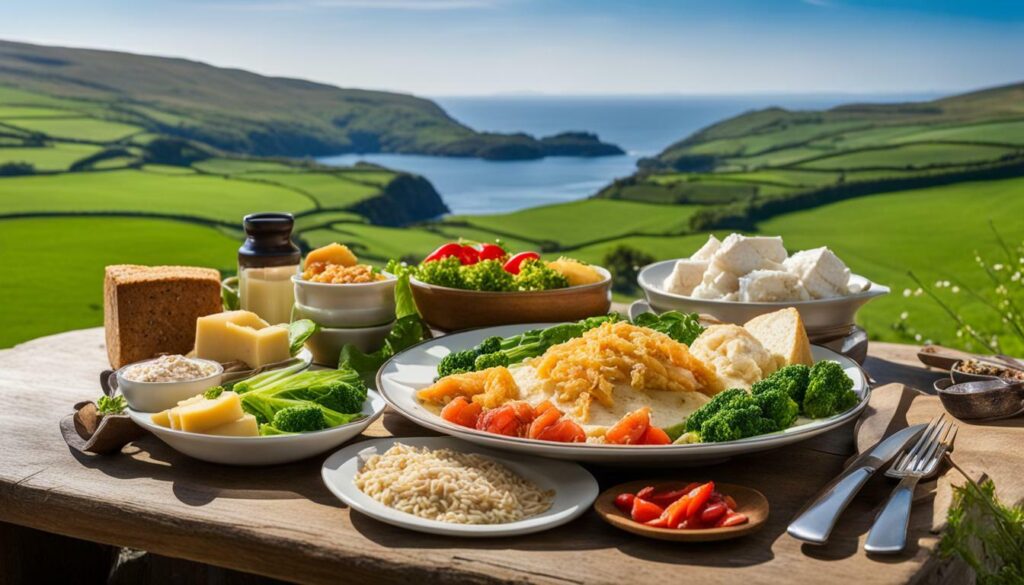
Chemical Analysis of Pottery
The analysis of ancient pottery offers valuable clues about the famous foods that graced Irish tables in the past and the composition of a traditional Irish meal. Through chemical analysis, researchers can uncover the ingredients and cooking techniques used by our ancestors, shedding light on the culinary practices of historical Ireland.
One method used in the study of Irish diets is the examination of cooking vessels, such as pots and pans, for residues and traces of food. By analyzing the chemical composition of these artefacts, scientists can determine the types of food that were cooked and consumed. This information provides insights into the staple foods, cooking methods, and flavour profiles that were prevalent in Irish cuisine.
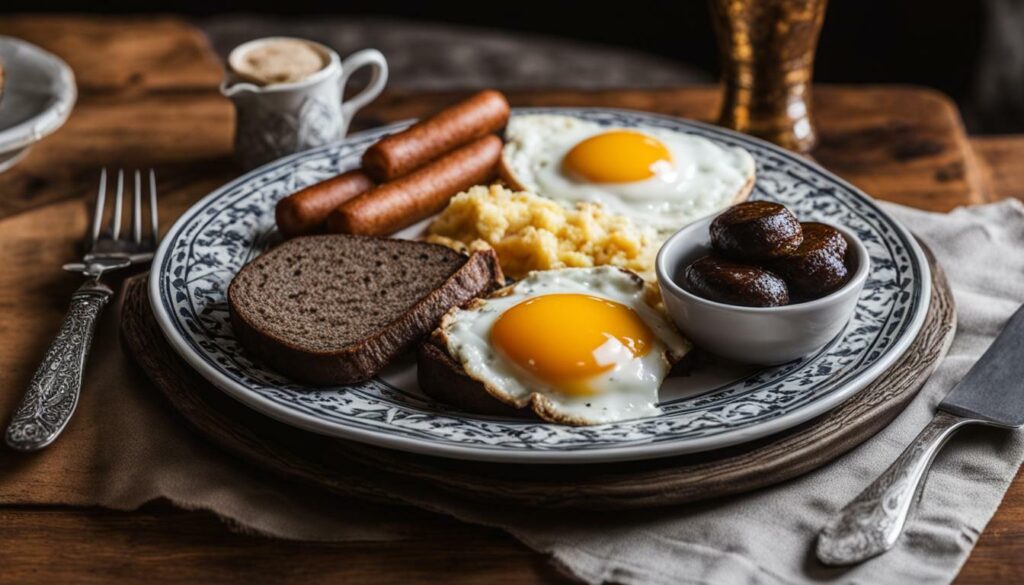
Chemical analysis of pottery has revealed the presence of various food items in Irish meals. For example, the residue found in some pottery fragments suggests the use of dairy products, such as butter and cheese. This indicates the importance of dairy in Irish cuisine, as these ingredients were likely used in a wide range of dishes.
Furthermore, the analysis has also uncovered evidence of the consumption of grains, meats, and vegetables. These findings highlight the diverse range of ingredients that contribute to a traditional Irish meal. From hearty stews to savoury pies, the Irish diet was a rich tapestry of flavours and textures.
Famous Foods in Ireland
The chemical analysis of pottery not only provides us with a glimpse into the past but also helps us to celebrate the famous foods that have shaped Irish culinary traditions. Dishes like colcannon, boxty, and soda bread have become iconic symbols of Irish cuisine, showcasing the ingenuity and resourcefulness of the Irish people.
| Dish | Description |
|---|---|
| Colcannon | A traditional Irish dish made with mashed potatoes, cabbage or kale, and butter. It is often served on Halloween, known as “Colcannon Night”. |
| Boxty | A potato pancake made with grated or mashed potatoes, flour, and buttermilk. It is typically served with breakfast or as a side dish. |
| Soda Bread | A type of quick bread made with baking soda as the leavening agent. It is a staple in Irish households and is often enjoyed with butter or served alongside stews and soups. |
The legacy of these famous foods continues to thrive in modern Irish cuisine, showcasing the rich culinary heritage of the country. From the ancient pottery shards to the modern-day kitchen tables, the study of Irish diets reminds us of the importance of preserving and celebrating our food traditions.
The Legacy of Traditional Irish Foods
Traditional Irish foods continue to hold a special place in the hearts and palates of the Irish people, representing the nation’s culinary heritage. From hearty stews to freshly baked soda bread, these dishes have been passed down through generations, preserving a connection to the past and a sense of national identity. The rich flavours and comforting aromas evoke memories of home and family gatherings, making them an integral part of Irish culture.
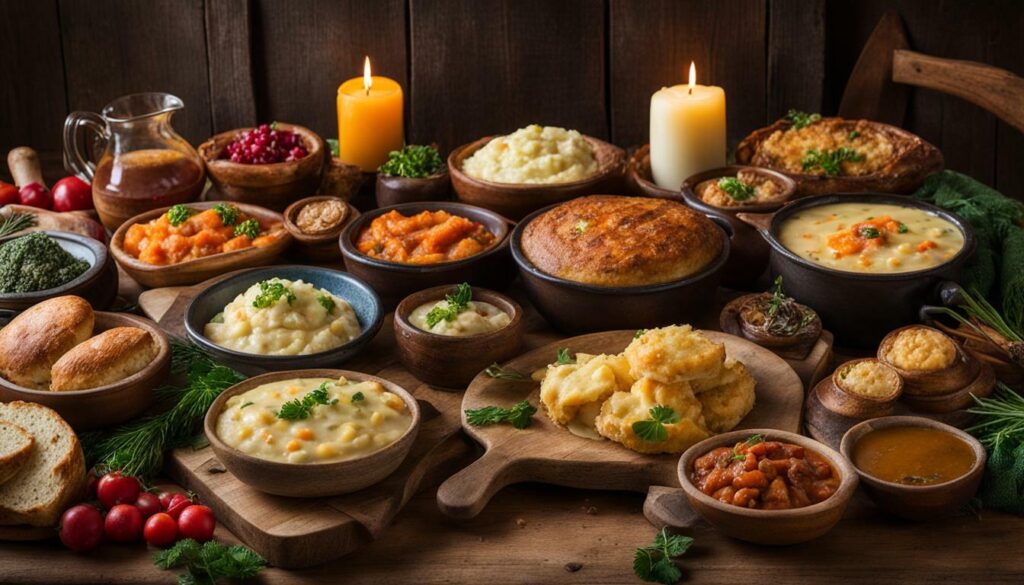
One such iconic dish is Irish stew, a hearty and nourishing mix of lamb or mutton, potatoes, onions, carrots, and herbs. Dating back centuries, this simple yet flavoursome dish was a staple in Irish households, providing sustenance and warmth during harsh winters. Another traditional favourite is colcannon, a delicious combination of mashed potatoes, cabbage or kale, and butter. It is often served alongside a succulent joint of meat or as a main course, showcasing the humble ingredients that are abundant in Irish agriculture.
The Irish breakfast, known for its hearty portions, is another cherished tradition. It typically includes bacon rashers, sausages, black and white pudding, eggs, grilled tomatoes, and soda bread. This substantial meal ensures a satisfying start to the day and reflects the agricultural roots of Irish society. Additionally, seafood lovers can indulge in a variety of dishes that showcase the abundance of fresh fish and shellfish found in Ireland’s coastal waters, such as smoked salmon, Dublin Bay prawns, and oysters.
| Traditional Irish Foods | Key Ingredients |
|---|---|
| Irish Stew | Lamb or mutton, potatoes, onions, carrots, herbs |
| Colcannon | Mashed potatoes, cabbage or kale, butter |
| Irish Breakfast | Bacon rashers, sausages, black and white pudding, eggs, grilled tomatoes, soda bread |
| Seafood | Smoked salmon, Dublin Bay prawns, oysters |
The legacy of traditional Irish foods extends beyond their culinary appeal. They serve as a gateway to understanding the history and culture of Ireland. Each dish tells a story of the land, the people, and the resources available. They are a testament to the resilience of the Irish people, who were able to create delicious and nourishing meals with simple ingredients. By preserving and celebrating these traditional dishes, the Irish continue to honor their heritage and pass on a taste of their culture to future generations.
“Traditional Irish foods are more than just sustenance; they are a link to our past and a celebration of our shared identity.” – Irish chef
Explore the Flavors of Ireland
Visitors to Ireland have the opportunity to experience the flavours of traditional Irish cuisine firsthand. From cosy pub lunches to fine dining experiences, there are countless establishments that showcase the best of Irish cooking. Whether you fancy a bowl of hearty stew, a plate of fresh seafood, or a slice of warm soda bread, the culinary delights of Ireland are sure to leave you satisfied and wanting more.
Culinary Evolution and Modern Irish Cuisine
Irish cuisine has evolved and transformed over the years, embracing new flavours and culinary techniques while preserving its traditional roots. Today, the cuisine of Ireland is a vibrant fusion of old and new, influenced by historical traditions, international flavours, and modern innovations.
The rich history and cultural diversity of Ireland have contributed to the development of a unique culinary landscape. Traditional Irish dishes like colcannon, Irish stew, and soda bread still hold a special place in the hearts and stomachs of the Irish people. These iconic dishes showcase the simplicity and wholesome ingredients that have been at the core of Irish cooking for centuries.
However, modern Irish cuisine has also embraced international flavours and cooking styles. As Ireland has become more connected to the global community, chefs and home cooks alike have been inspired to experiment with different ingredients and techniques. The result is a culinary scene that boasts a wide range of gastronomic delights, from trendy farm-to-table restaurants to innovative fusion cuisine.

To truly understand the culinary evolution in Ireland, it is important to appreciate the country’s commitment to sustainable and locally sourced ingredients. Many restaurants and food producers in Ireland prioritize using fresh, seasonal produce and supporting local farmers and artisans. This dedication to quality and ethical sourcing has elevated the Irish food scene to new heights.
Traditional Irish dishes with a modern twist
One of the most exciting aspects of modern Irish cuisine is the reinvention of traditional dishes. Chefs and food enthusiasts are constantly finding creative ways to put a contemporary spin on classic recipes. For example, you might find a modern twist on colcannon that incorporates trendy ingredients like kale or wild garlic. Or perhaps a chef will experiment with flavours by adding a unique ingredient to a traditional Irish stew.
This innovation and experimentation have given rise to a new wave of culinary creativity in Ireland. The fusion of traditional Irish flavours with international influences has resulted in dishes that are both comforting and exciting, showcasing the best of both worlds.
Table: Traditional Irish Dishes
| Dish | Description |
|---|---|
| Colcannon | A traditional Irish dish made with mashed potatoes, cabbage or kale, and butter. Often served with bacon or ham. |
| Irish Stew | A hearty stew made with lamb or mutton, potatoes, onions, and other seasonal vegetables. Slow-cooked for hours to develop rich flavours. |
| Boxty | A type of potato pancake made with grated raw potatoes, mashed potatoes, flour, and buttermilk. Served with a variety of toppings. |
| Soda Bread | A traditional Irish bread made with baking soda instead of yeast. Quick and easy to make, with a dense and slightly sweet flavour. |
As Ireland continues to embrace its culinary heritage while embracing new influences from around the world, the future of Irish cuisine looks incredibly promising. With a diverse range of flavours, innovative techniques, and a commitment to sustainability, Irish cuisine is sure to captivate the taste buds of food enthusiasts for years to come.
Festive Foods in Ireland Today
Festive foods continue to play a significant role in Irish culture, with traditional dishes taking centre stage during special occasions and holidays. These beloved culinary creations are not only delicious but also hold deep-rooted cultural significance, connecting people to their Irish heritage and traditions. From St. Patrick’s Day celebrations to Christmas feasts, here are some of the traditional foods that are still enjoyed in Ireland today.
St. Patrick’s Day: A Feast of Irish Delights
On St. Patrick’s Day, the celebration of Ireland’s patron saint, Irish tables are adorned with a variety of festive foods. Corned beef and cabbage, a quintessential dish associated with Irish-American cuisine, is a popular choice for this festive day. The salted and cured meat paired with flavorful cabbage represents the fusion of Irish and American culinary traditions.
Another beloved St. Patrick’s Day treat is soda bread, a traditional Irish bread made with simple ingredients like flour, baking soda, buttermilk, and salt. Its dense texture and slightly tangy taste make it the perfect accompaniment to hearty stews and soups.
Christmas Traditions: A Feast Fit for a Family
During the Christmas season in Ireland, families come together to enjoy a lavish spread of festive foods. Roast turkey or ham takes centre stage, accompanied by an assortment of sides like buttery mashed potatoes, Brussels sprouts, and stuffing made with breadcrumbs, herbs, and spices.
One of the most cherished Christmas desserts in Ireland is the traditional Christmas pudding. Made with suet, dried fruits, spices, and a splash of Irish whiskey, this rich and moist pudding is often served flambeed, doused in warm brandy and set alight for a dramatic presentation.
Easter Delights: A Sweet Celebration
Easter in Ireland brings an array of sweet treats and indulgent delights. Traditional Irish Easter eggs, made with rich chocolate and filled with a variety of surprises, are eagerly anticipated by children and adults alike. Another Easter favourite is the hot cross bun, a spiced and fruity sweet bun adorned with a signature pastry cross, symbolizing the crucifixion.
These festive foods not only satisfy the taste buds but also serve as a reminder of the rich cultural heritage that has shaped Irish cuisine. Whether it’s celebrating St. Patrick’s Day, Christmas, or Easter, these traditional dishes continue to bring families and communities together, creating cherished memories and strengthening the bonds of Irish tradition.
| Festive Occasion | Traditional Food |
|---|---|
| St. Patrick’s Day | Corned beef and cabbage |
| Soda bread | |
| Christmas | Roast turkey or ham |
| Mashed potatoes | |
| Brussels sprouts | |
| Stuffing | |
| Christmas pudding | |
| Easter | Irish Easter eggs |
| Hot cross buns |
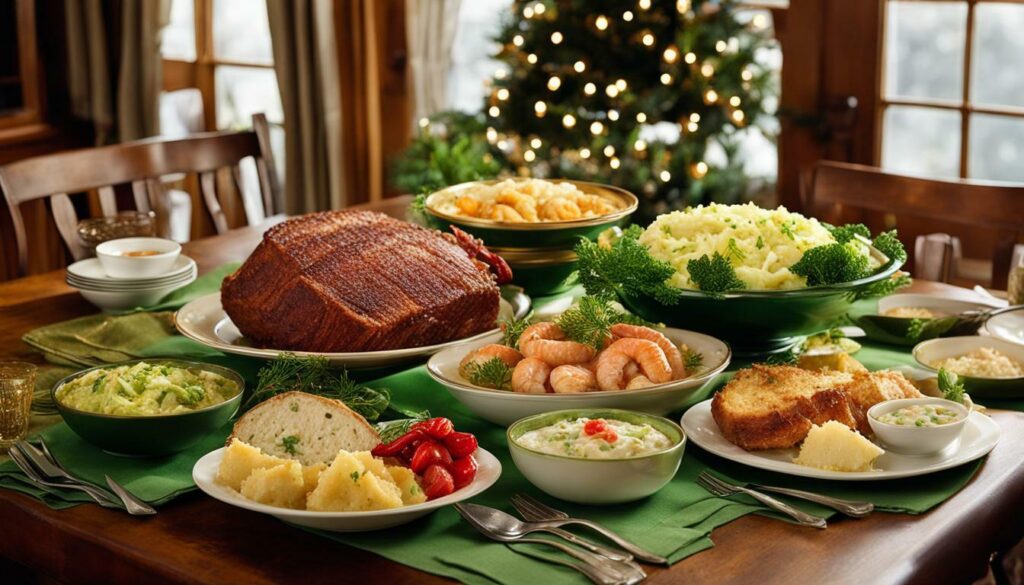
Conclusion
The past and present diets of Ireland offer a fascinating glimpse into the history, traditions, and cultural identity of the Irish people. A five-year interdisciplinary study funded by the European Research Council is currently underway to explore the complexities of Irish food culture in the 16th and 17th centuries. Through the combination of historical records, molecular analysis, and chemical analysis of pottery, this study aims to shed light on various aspects of Irish diets, including the impact of war, social class differences, and the influence of globalisation.
By delving into the eating habits of the past, we can gain a deeper understanding of the foundations upon which modern Irish cuisine has been built. Traditional Irish foods, once a necessity for survival, have evolved into national treasures that symbolise both the rich history and vibrant culture of Ireland. From hearty stews and colcannon to succulent roast meats and festive specialities, these dishes continue to be enjoyed and celebrated in Ireland today.
Furthermore, this study aims to trace the evolution of Irish cuisine and explore how it has adapted to changing tastes and influences over time. The introduction of new ingredients and cooking techniques, alongside the fusion of international cuisines with traditional Irish foods, has created a diverse and exciting culinary scene in Ireland. This culinary evolution has not only added new dimensions to Irish cuisine but has also given rise to a thriving food culture that showcases the creativity and ingenuity of Irish chefs and food producers.
Ultimately, the exploration of past and present diets of Ireland highlights the interconnectedness of food and culture. From the impact of historical events on available ingredients to the influence of social norms and religious beliefs on dietary choices, food has played a central role in shaping Irish identity. As we continue to uncover the secrets of traditional Irish foods and embrace the innovations of modern Irish cuisine, we honour the rich culinary heritage of Ireland and ensure its continued legacy for future generations.
FAQ
What is the purpose of the study on the diet and eating habits of Irish communities in the 16th and 17th centuries?
The study aims to explore questions such as whether there was a food culture in Ireland before the arrival of the potato, the impact of war on diet, and the differences in diet between the lower classes and the elite. It also aims to understand the impact of globalization on the Irish diet and how new ideas about manners, health, and religion influenced the diet of Irish communities.
What methods will be used in the study?
The study will combine historical records, molecular analysis of skeletons and animal bones, and chemical analysis of pots from the period to gain a comprehensive understanding of the diet and eating habits of Irish communities in the 16th and 17th centuries.
How does the study aim to understand the impact of globalization on the Irish diet?
The study will explore how globalization has influenced the Irish diet by examining the introduction of new ingredients and cooking techniques, as well as the fusion of international cuisines with traditional Irish foods.
What insights can be gained from the study of historical records and molecular analysis?
By studying historical records and conducting molecular analysis of skeletons and animal bones, researchers can uncover information about the types of food consumed, dietary practices, and the impact of factors such as social class and war on the diet of Irish communities in the 16th and 17th centuries.
How does the chemical analysis of pottery contribute to the study of Irish diets?
Chemical analysis of pottery can provide insights into the ingredients and cooking techniques used in traditional Irish meals. By studying ancient cooking vessels, researchers can better understand the dietary practices of historical Ireland.
Source Links
- https://www.irishtimes.com/news/science/what-was-the-food-culture-in-ireland-before-the-potato-1.4245606
- https://physicalculturestudy.com/2015/06/07/the-traditional-irish-diet/
- https://irishfoodhub.com/exploring-the-roots-of-irish-cuisine/



